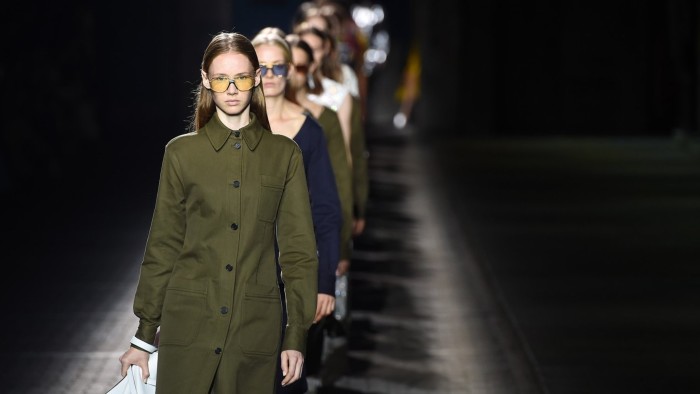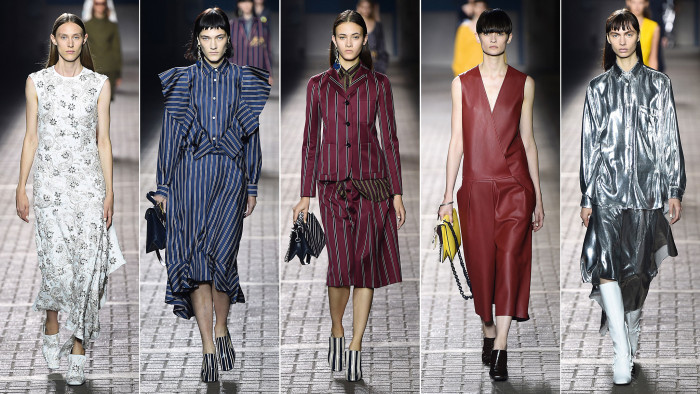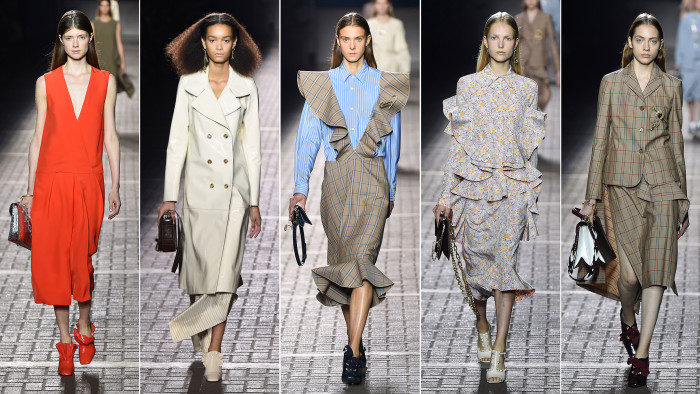Mulberry SS17 show report: London Fashion Week

Simply sign up to the Life & Arts myFT Digest -- delivered directly to your inbox.
The prime minister Theresa May and her cabinet may be fractious over the future of the British education system and the stain of privilege upon one’s social mobility, but the props of elitism and old world order are still firm favourites in fashion. Kent and Curwen, first founded in 1926 as a school outfitter and purveyor of club colours to the cricketing classes, has just been rebranded by designer Daniel Kearns and consultant David Beckham. The starting points for the new collection, which was presented this weekend and will launch in November, were an archive book of ties, a faded football jersey and a cricket sweater. Classroom war? Not on our catwalks.
At Mulberry also, the Spanish designer Johnny Coca had taken the striped blazer as inspiration to create a modern take on the uniform. Blazers were boxy and worn with culottes, cut loose with front pleats to look like skirts. The wools had been woven in England by a school supplier and were worn with a curve-heeled mule which gave the prep-school ensembles a flamboyant French revolutionary flourish.

I’ve always maintained that the average Brit remains cautious about getting dressed because their sartorial education is stymied by years of mandatory school wear. While the French start experimenting with scarf ties and trouser lengths as infants, our style evolution remains worryingly dependent on a wardrobe of white shirts and polyester skirt suits until we turn 16. No wonder we cling to navy blue sweaters as comfort blankets.
This then was pleasingly familiar. But it was anything but boring. “It’s a uniform without uniformity,” explained Coca who had been playing with lots of British sartorial traditions and reinterpreting them. The results were a mash-up, WC Fields meets Mitford meets Savile Row: yet it was urban and exciting. A classic Paisley design in crystal beads was embroidered on eveningwear and shoes. There were Prince of Wales checks manufactured in the UK, bejewelled kilt pin brooches (Coca himself wears a kilt most days), drill jackets, granny florals flounced with bonded silk ruffles and vibrant coloured asymmetric velvet evening dresses. Asymmetry will be a huge trend next season. Coca likes it because it “breaks the silhouette and looks more flattering.”

After the harder, tough-edged attitude of his first collection (which I struggled to fall in love with) there were plenty of things to crush on here. A cognac-coloured leather pantsuit was especially good, as were the suiting fabrics. The bags were also as one would expect of the former Celine designer who was head of accessories and jewellery before his appointment to Mulberry. The company’s first positive company figures (total revenue grew by 5% to £155.9m according to figures released in June), have encouraged Coca to define the brand with more confidence. The key to his accessories success, he maintained, has been in revisiting the older “hero” pieces of the house and finessing them while adding in new bits: the old Piccadilly bag was here outsized and lined in a scarf print, the bestselling Bayswater had been remade with stripy webbing details. The new Cherwell meanwhile was a delicious take on the lunchbox with a zipper lid fastening. It came in neutrals, navy (of course), or jazzed up with horizontal stripes, and a little contrast pouch. It will retail for around £850. Far, far too lovely to sully with sandwiches.
The other key to this collection’s coolness was found in Lotta Volkova. The 32-year-old Russian stylist has been instrumental in shaping the look of Vetements and Balenciaga around which a fever of excitement now exists. She had been called upon to style this collection — and her eye was clearly visible in this collection and especially in the silver dresses and the velvets. Getting Volkova onboard was very clever. The show, staged in a very random warehouse space in London’s docklands, had a frisson. And I predict the Mulberry club is about to admit a whole new tribe of members.
Photographs: Catwalking
Comments